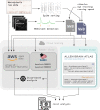Sharing neurophysiology data from the Allen Brain Observatory
- PMID: 37432073
- PMCID: PMC10335829
- DOI: 10.7554/eLife.85550
Sharing neurophysiology data from the Allen Brain Observatory
Abstract
Nullius in verba ('trust no one'), chosen as the motto of the Royal Society in 1660, implies that independently verifiable observations-rather than authoritative claims-are a defining feature of empirical science. As the complexity of modern scientific instrumentation has made exact replications prohibitive, sharing data is now essential for ensuring the trustworthiness of one's findings. While embraced in spirit by many, in practice open data sharing remains the exception in contemporary systems neuroscience. Here, we take stock of the Allen Brain Observatory, an effort to share data and metadata associated with surveys of neuronal activity in the visual system of laboratory mice. Data from these surveys have been used to produce new discoveries, to validate computational algorithms, and as a benchmark for comparison with other data, resulting in over 100 publications and preprints to date. We distill some of the lessons learned about open surveys and data reuse, including remaining barriers to data sharing and what might be done to address these.
Keywords: data sharing; electrophysiology; mouse; neurophysiology; neuroscience; open science; two photon calcium imaging.
© 2023, de Vries, Siegle et al.
Conflict of interest statement
Sd, JS, CK No competing interests declared
Figures



Update of
- doi: 10.48550/arXiv.2212.08638
References
-
- Abbott LF, Angelaki DE, Carandini M, Churchland AK, Dan Y, Dayan P, Deneve S, Fiete I, Ganguli S, Harris KD, Häusser M, Hofer S, Latham PE, Mainen ZF, Mrsic-Flogel T, Paninski L, Pillow JW, Pouget A, Svoboda K, Witten IB, Zador AM. An international laboratory for systems and computational neuroscience. Neuron. 2017;96:1213–1218. doi: 10.1016/j.neuron.2017.12.013. - DOI - PMC - PubMed
-
- Abe T, Kinsella I, Saxena S, Buchanan EK, Couto J, Briggs J, Kitt SL, Glassman R, Zhou J, Paninski L, Cunningham JP. Neuroscience cloud analysis as a service: an open-source platform for Scalable, reproducible data analysis. Neuron. 2022;110:2771–2789. doi: 10.1016/j.neuron.2022.06.018. - DOI - PMC - PubMed
-
- Allen Institute Mindscope Program Allen Brain Observatory – 2-photon Visual Coding (Dataset) 2016. [July 5, 2023]. https://brain-map.org/explore/circuits
-
- Allen Institute MindScope Program Allen Brain Observatory – Neuropixels Visual Coding (Dataset) 2019. [July 5, 2023]. https://brain-map.org/explore/circuits
Publication types
MeSH terms
LinkOut - more resources
Full Text Sources
Research Materials

